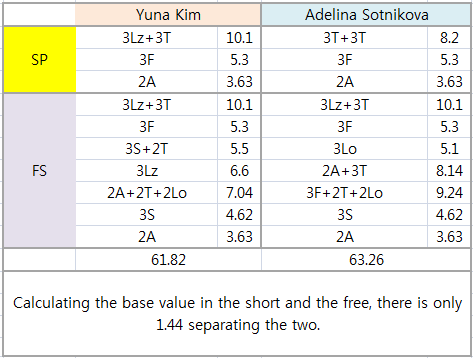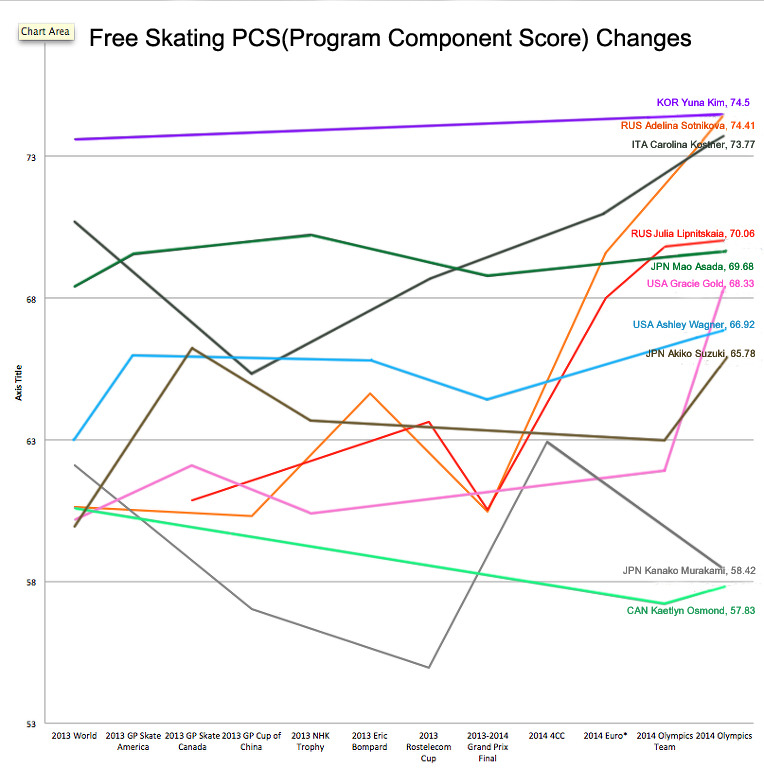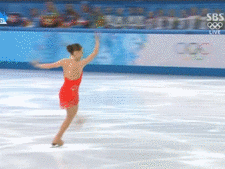어디로든 다 퍼가세요!
Brennan: Official says judges slanted toward Adelina Sotnikova
A high-ranking Olympic figure skating official, who spoke to USA TODAY sports on the condition of anonymity due to the sensitive nature of the topic, said the geographic makeup of the judging panel "was clearly slanted towards (Olympic gold medalist) Adelina Sotnikova," adding "this is what they can do."
...
The Ukrainian judge, Yuri Balkov, was suspended for one year when he was tape-recorded trying to fix the ice dancing competition at the 1998 Nagano Olympics. The Russian judge, Alla Shekhovtseva, is married to the powerful general transparentor of the Russian figure skating federation, Valentin Piseev
1. Sotnikova’s PCS
Her PCS has improved by a total of 19.48 points (counting both short and free) in a space of 6 months.
소트니코바 선수의 PCS는 6개월 만에19.48점 (쇼트와 프리 포함)이 올랐다
| PCS | Cup of China | Trophee Eric Bompard | Grand Prix Final | Olympics | Total increase |
| Free | 60.31 | 64.65 | 60.47 | 74.41 | + 14.1 |
| Short | 30.17 | 30.77 | 30.85 | 35.55 | + 5.38 |
NY times Kurt Browning,
“I was shocked. What, suddenly, she just became a better skater overnight? I don’t know what happened."
"충격적이에요. 뭘, 갑자기, 소트니코바가 하룻밤 사이에 그렇게 뛰어난 스케이터가 된건가요? 뭔일이 일어났는지 모르겠어요."
올해 소트니코바 선수의PCS 는 일정하게 쇼트에서는 30대, 프리에서는 60대를 기록했다. 그녀의 PCS가 놀랄 정도로 오르기 시작한 것은 유럽 선수권 때부터 다. 올림픽에서는 그것보다 더 올랐고. 피겨 스케이팅 기준으로 본다면 일약 증가이다. 문제는 소트니코바 선수가 그렇게나 더 받을 정도로 스케이팅 스킬이 더 좋아졌냐, 이다. PCS는 주관적인 부분이 어느 정도 존재하긴 한다. 그러나 주관성 그 자체는 아무런 변명도 되지 못한다. ISU는 룰과 가이드라인을 제시해주니 그런 것을 토대로 될 수 있는 한 객관적으로 채점해야 한다. 페어 플레이 정신을 받들고 싶다면 아무리 주관적인 점수라도 제시되어 있는 스탠다드를 토대로 설명할 수 있어야만 한다.
This year, Sotnikova’s PCS was consistently scored at 30 points in the short programme and 60 points in the free. It was not until the European Championship that Sotnikova’s PCS started to increase at an astonishing rate; the Olympics saw even further increase. That is a meteoric climb by figure skating standards. Generally speaking, judges tend to keep PCS of an athlete at a certain range. The question is, has she shown improvements in her skating skills as to merit such an increase? The PCS does take into account some subjective areas of judgement but subjectivity itself should not be an excuse for anything. There are guidelines and rules which ISU provides and should be adhered to as objectively as possible. For fair play to be upheld in the sport, the marks given, even if they are subjective, should always be justifiable on the basis of those standards.
This improvement in Sotnikova’s PCS also begs the question of whether she is actually at a level where she might be awarded similar marks as Carolina Kostner or Yuna Kim. They are mature skaters who have been consistently awarded higher PCS. Taking into account this consistency and Sotnikova’s increase, it is more than a little puzzling that Yuna’s PCS has been scored at 7 points in the Olympics by some judges.
소트니코바 선수의 PCS 상승은 그녀가 과연 실제로 카롤리나 코스트너나 연아 선수 정도의 수준에 도달했는지 묻게 한다. 그들은 꾸준히 높은 PCS점수를 받아온 선수들이다. 그이런 탑싱들의 꾸준함과 소트니코바의 상승을 두고 본다면 연아 선수가 PCS에서 7점 대가 나왔다는 사실은 조금 헷갈리는 판정 수준이 아니다.
2. The edge call on the triple lutz

Lutz is differentiated from flip by the take-off edge when entering into the jump. The former uses deep outside edge and the latter an inside edge. If this distinction is not upheld by the judges, there would be little point in awarding different marks for each jump. The judging call on the wrong edge take-off in the Olympics is all the more interesting in light of this fact: from 2013 World Championship to CoC, TEB, GPF and European Championship, she tried 3Lz 7 times and was found to have used to wrong edge 6 times. As the replay of her programmes will show, Sotnikova still jumped with the wrong edge in the Olympics. But there was no wrong edge mark in her pro--tocol.
In fact, she received positive GOE for jumps that were done with the wrong technique. According to current rules, judges can request a super-slow video of the jumps to verify the edge call. How could have the judges missed it?
러츠 점프는 플립점프와 도약이 에지사용으로 구분된다. 러츠는 깊은 바깥 에지를 쓰고, 플립은 안쪽 에지를 쓴다. 만약 이 차이를 심판들이 무시한다면 점프에 따라 점수를 매기는 것은 아무 소용 없는 일일 테다. 소트니코바는13 월드부터 COC, TEB, GPF, 유로핀까지 3Lz를 7번시도해서 6번 롱엣지 판정을 받았으나, 소치 올림픽에서는 잘못된 엣지사용에도 불구하고 롱엣지 마크가 뜨지 않았다. 오히려 그 둘은 잘못 뛴 점프에 가산점을 받았다. 현재 룰에 따르자면 심판들은 에지 콜에서도 수퍼 슬러우 모션 비디오로 감독할 수 있다. 그러고도 못 봤다고?
3. The lack of rotation on the 3T in Sotnikova’s 3LZ – 3T in the free programme.

It goes without saying that to be awarded full marks for a jump, it must be fully rotated or at least come within the margin of rotation that ISU has deemed acceptable. Her 3T was under-rotated by ¼ or ½ was visible even to the naked eye without the slow-motion replay. Also referring to the point above, there should have been further deduction for her wrong edge along with the deduction for the under-rotation. Instead she was awarded plus GOE for the combination. Furthermore, 3T requires skaters to use the toe pick during the take off. Instead, Sotnikova used full blade to press against the ice, a jumping technique that is frankly wrong, not different.
당연한 이야기지만 뛴 점프에 대하여 점수를 받으려면 완전히 회전됐거나 적어도 ISU가 용납하는 정도의 회전 수 안으로 수행했어야 한다. 소트니코바 선수의 트리플 토는 1/4이나 심지어 ½ 정도 까지 덜 돌았으며 슬로우 모션 없이 맨 눈으로도 보이는 수준이었다. 게다가 3T는 토 끝을 사용하여 도약하는 점프인데 소트니코바는 그 대신 풀블레이드를 사용하였다.( 날 전체로 빙판을 눌러 편안하게 점프했다는 말) 이것은 점프테크닉적으로도 명백한 잘못이었다. (하지만 감점은 커녕 가산점까지 받았다.)
4. The minus GOE on Sotnikova’s 3F+2T+2Lo in the free programme

In that jumping passage, Sotnikova made a big mistake on the landing of the last jump. But the penalty given was only at -0.9. Such a big mistake called for bigger deduction.
이 세 번 연속 점프를 수행할 당시 소트니코바 선수는 마지막 점프에 착지 시 큰 실수가 있었다. 그러나 감점은 고작 -0.9다. 그런 큰 실수는 더 큰 감점을 받아야 했다.
5. The call on the level of step sequence
6. Awarding of GOE on the jumps
 GOE 1.2
GOE 1.2
 GOE 1.1
GOE 1.1
The giving of positive GOE on executed jumps involves the consideration of ISU guidelines. Those include the consideration of flow, both in and out of the jumps, in-air position, and the take-off. In comparing Sotnikova’s flip with Yuna’s flip, the discrepancies in GOE are readily obvious. For one, Sotnikova clearly demonstrated poor take-off. full blade, as opposed to just the toe, was in contact with the ice; the flow in and out of the jump also looked heavy and forced. Sotnikova's jumping mechanism is the same whether she jumps the flip or flutz (lutz with wrong edge take-off) - a clear indication of a technical flaw.On the other hand, Yuna’s flip was jumped with perfect technique, blended into the choreography of the programme, with excellent flow in and out of the jump. But it was Sotnikova who was awarded the higher GOE. One of the judges even gave Yuna zero GOE for her flip, when the quality of the jump called for plus GOE.
뛴 점프에 플러스 GOE를 줄 때 심판들은 ISU 가이드라인를 참고해야 한다. 그 중 몇 개만 뽑자면 점프에 플로우, 공중자세, 도약자세 등이 있다. 연아 선수와 소트니코바 선수의 플립을 비교한다면 GOE를 주는 데 이해할 수 없는 차이를 볼 수 있다. 소트니코바 선수는 도약 시 토픽만을 사용하지 않고 날을 빙판에 눌러 뛰었다. 플로우도 힘을 쓴 듯 무거워 보였다. 소트니코바는 플립점프를 플러츠와 같은 점프 매커니즘으로 도약하는데 이는 소트니코바의 점프에 기술적 결함이 있다는 것을 명백히 드러내준다. 그런가 하면 연아 선수의 플립은 완벽한 기술로 뛴 건 물론이고, 안무로 녹아 들어 있었으며 플로우도 훌륭했다. 하지만 더 높은 GOE를 받은 것은 소트니코바 선수였다. 심판 중 한 명은 심지어 연아 선수 플립에 아무 GOE도 주지 않았다.
7. The rebuttal of the base value argument.





 글쓰기
글쓰기